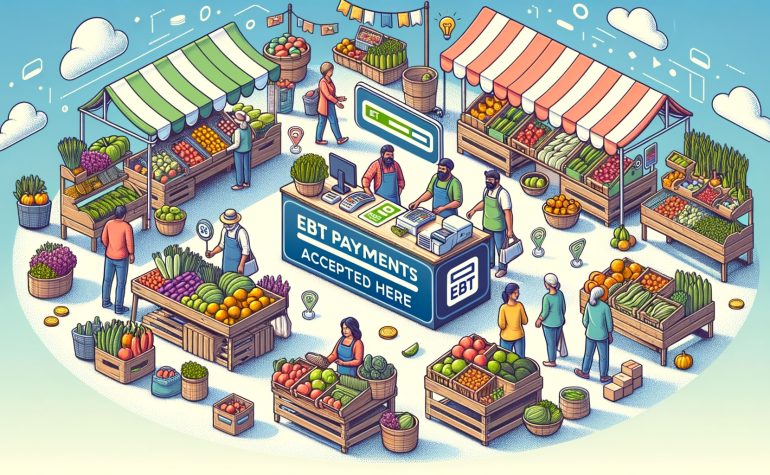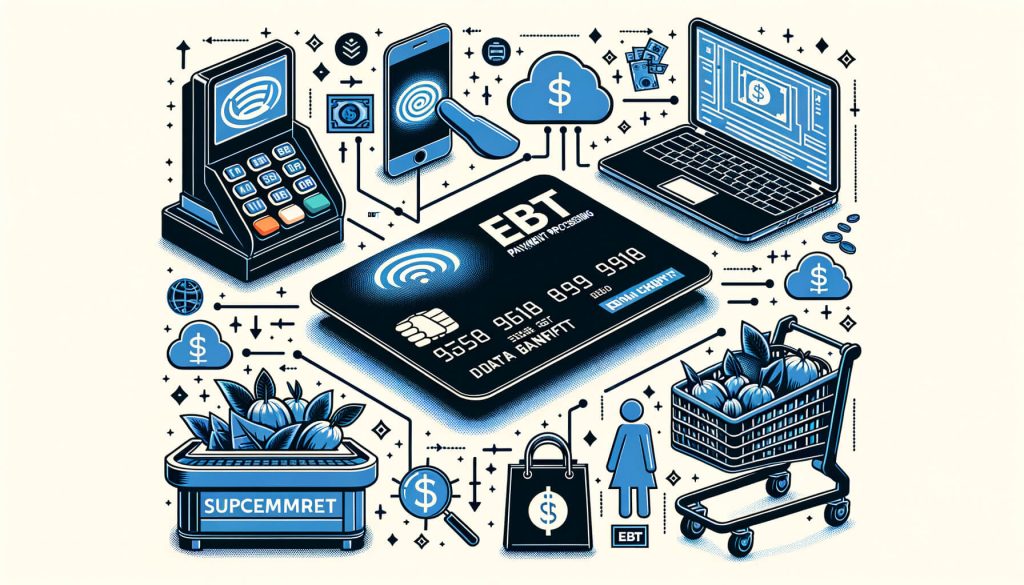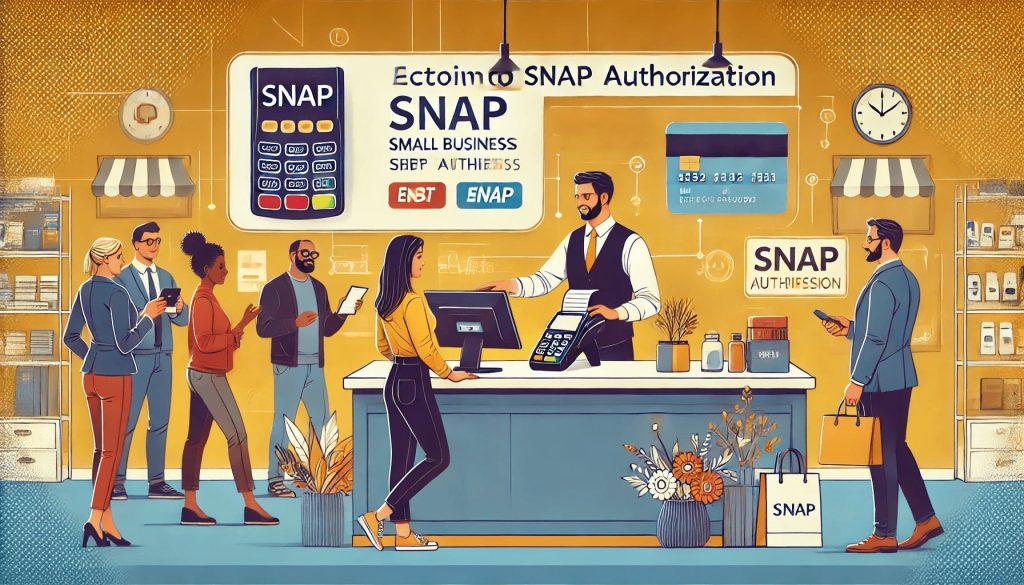
By manoj November 26, 2024
Setting up EBT (Electronic Benefits Transfer) payment processing in a farmer’s market is a powerful initiative that benefits both the community and the local economy. By enabling customers who rely on the Supplemental Nutrition Assistance Program (SNAP) to use their benefits, farmer’s markets can promote healthier eating habits, increase access to fresh produce, and support small-scale farmers.
This detailed guide walks through every step of the process, from understanding what EBT is to promoting its acceptance and ensuring compliance. By the end of this article, you will have a clear roadmap to successfully implement EBT payment processing in your farmer’s market, fostering inclusivity and driving growth.
What Is EBT Payment Processing?

EBT payment processing refers to the electronic system that allows SNAP recipients to purchase eligible food items using their government-issued EBT card. The card works similarly to a debit card, enabling participants to make payments for approved purchases directly from their SNAP accounts.
How EBT Payment Processing Works
The process involves specialized terminals or card readers capable of reading EBT cards. When a customer uses their card, the transaction is processed electronically, deducting the amount from their SNAP balance. This system ensures secure and seamless payments, enabling customers to purchase fresh, healthy food easily.
Features of EBT Payment Processing:
- Electronic Transactions: Funds are deducted instantly from the customer’s SNAP balance.
- Secure System: Transactions are encrypted, protecting both customer and vendor information.
- SNAP Compliance: Transactions are limited to eligible items, ensuring adherence to program guidelines.
EBT payment processing is especially important for farmer’s markets, as it modernizes payment systems, accommodates a broader customer base, and creates opportunities for underserved populations to access fresh produce.
Why EBT Payment Processing Matters
Integrating EBT payment processing into a farmer’s market is about more than just accepting payments; it’s about building a stronger, healthier, and more inclusive community. Farmer’s markets are unique spaces that bring together fresh, locally sourced foods and diverse customers. By accepting EBT, they extend their reach and impact, making healthy eating more accessible to those who need it most.
Community Impact of EBT Acceptance
EBT processing helps bridge the gap between farmers and low-income families by fostering equitable access to fresh, nutritious food. It supports local economies and aligns with public health goals, promoting better eating habits while boosting vendor sales.
Why It’s Essential for Farmer’s Markets:
- Inclusivity: Ensures that everyone, regardless of income, has access to fresh and healthy foods.
- Economic Growth: Boosts sales for vendors by attracting a larger customer base.
- Public Health Benefits: Encourages SNAP recipients to invest their benefits in nutritious, locally grown foods.
- Enhanced Market Reputation: Positions the market as a community-centered space that values diversity and accessibility.
By accepting EBT payments, farmer’s markets fulfill a dual purpose: they serve as a hub for fresh food and a driver of community well-being, creating lasting impacts for both vendors and customers.
Key Benefits of EBT Payment Processing

Adopting EBT payment processing provides several advantages for farmer’s markets, vendors, and customers alike. This section explores the specific benefits that make EBT acceptance a worthwhile investment for markets.
Benefits for the Market
- Increased Foot Traffic: EBT acceptance attracts SNAP recipients who may not have shopped at the market otherwise.
- Broader Demographics: Welcoming a diverse audience strengthens the market’s community appeal.
- Improved Sales: More customers mean higher sales for participating vendors.
Benefits for Vendors
- New Revenue Streams: Vendors gain access to additional customers who rely on SNAP benefits.
- Enhanced Business Visibility: Being part of an EBT-accepting market positions vendors as inclusive and socially responsible.
Benefits for Customers
- Access to Fresh Food: SNAP recipients can purchase fresh produce, dairy, and other essentials directly from farmers.
- Community Connection: Shopping at a farmers market fosters a sense of belonging and supports local businesses.
By emphasizing these benefits, markets can build stronger vendor relationships and encourage community participation in the EBT program.
Step 1: Obtain SNAP Authorization

To accept EBT payments, farmers markets must first be authorized by the USDA to participate in the SNAP program. This process ensures compliance with federal regulations and confirms that the market meets eligibility criteria.
What Is SNAP Authorization?
SNAP authorization is the process by which the USDA certifies a retailer, including farmers markets, to accept EBT payments. Authorization is mandatory to ensure that only approved vendors sell SNAP-eligible items and comply with program guidelines.
Steps to Apply for SNAP Authorization
- Visit the USDA SNAP Retailer Portal
Begin by accessing the official USDA website, where you can find resources and apply online. - Create an eAuthentication Account
Register on the USDA’s eAuthentication platform to complete the application process. - Complete the Application Form
Provide detailed information about your market, including:- Market location and hours of operation
- Types of products sold (e.g., fruits, vegetables, dairy)
- Number of vendors participating
- Submit Required Documents
Upload necessary documentation, such as:- Taxpayer Identification Number (TIN)
- Business license or registration papers
- Vendor agreements or contracts
- Approval Process
Once the application is submitted, the USDA reviews it for compliance. Approval typically takes 30–45 days and may include a site visit or interview.
By obtaining SNAP authorization, markets gain the ability to legally accept EBT payments, paving the way for broader accessibility and increased sales.
Step 2: Acquire EBT-Compatible Equipment
After obtaining authorization, the next step is to acquire the necessary equipment to process EBT payments. This ensures smooth transactions for customers and vendors while maintaining compliance with federal guidelines.
Types of EBT-Compatible Equipment
There are several options for processing EBT payments, each tailored to the needs of farmers markets:
- Wired Terminals
- Require a stable internet or phone connection.
- Ideal for markets with permanent setups.
- Wireless Terminals
- Operate via cellular networks, making them suitable for outdoor or mobile markets.
- Mobile Card Readers
- Attach to smartphones or tablets through apps or Bluetooth.
- Cost-effective and portable, ideal for individual vendors.
Funding Options for Equipment
- Many states offer free or subsidized EBT equipment through SNAP programs.
- Check with local nonprofits or state agencies for additional funding support.
By selecting the right equipment, farmers markets can ensure that EBT payments are processed efficiently and securely.
Step 3: Train Staff and Vendors
Training is a critical step to ensure that everyone involved in the market, from staff to vendors, understands how to handle EBT transactions correctly. Proper training minimizes errors, enhances customer service, and ensures compliance with SNAP regulations.
Areas of Focus in Training
- Understanding SNAP Rules
- Educate vendors about eligible and ineligible items.
- Ensure vendors understand their responsibilities under SNAP guidelines.
- Operating Equipment
- Train staff and vendors to use EBT terminals or mobile card readers effectively.
- Customer Assistance
- Teach staff how to help customers with questions about using EBT cards.
- Record Keeping
- Emphasize the importance of accurate transaction logs for audits and reporting.
With well-trained staff and vendors, markets can create a smooth and welcoming experience for all customers.
Step 4: Implement a Token or Voucher System
Many farmers markets use a token or voucher system to simplify EBT transactions. This system allows customers to exchange their EBT benefits for tokens or vouchers, which can be used to purchase items from vendors.
How the Token System Works
- Central Terminal
Customers swipe their EBT card at a designated terminal to receive tokens equivalent to their SNAP benefits. - Vendor Transactions
Vendors accept tokens as payment for eligible items. - Redemption Process
Vendors redeem tokens at the market office for cash or checks.
This system streamlines transactions and ensures compliance with SNAP regulations.
Step 5: Promote EBT Acceptance
Promoting your market’s EBT program is essential to attract SNAP recipients and encourage participation. Effective marketing ensures that the community is aware of the benefits of shopping at an EBT-friendly market.
Strategies for Promotion
- Signage
- Display signs at entrances and vendor booths indicating EBT acceptance.
- Social Media Campaigns
- Use platforms like Facebook and Instagram to reach a wider audience.
- Community Partnerships
- Collaborate with local organizations to spread awareness about EBT acceptance.
- Incentive Programs
- Offer promotions like “Double Up Food Bucks” to encourage EBT usage.
Step 6: Ensure Compliance and Monitor Transactions
Compliance with SNAP regulations is crucial to maintaining authorization and ensuring smooth operations. Regular monitoring of transactions and vendor practices helps prevent errors and fraud.
Tips for Compliance
- Vendor Agreements
- Require vendors to sign contracts outlining their responsibilities under SNAP.
- Transaction Logs
- Maintain accurate records of all EBT transactions for audits.
- Fraud Prevention
- Train staff to recognize and prevent fraudulent activities.
By maintaining compliance, markets can continue serving their communities effectively.
Common Challenges and How to Overcome Them
Implementing EBT payment processing may come with challenges, such as technical issues or resistance from vendors. Addressing these proactively ensures a smoother process.
Solutions to Common Challenges
- Technical Issues: Invest in reliable equipment and provide troubleshooting training.
- Vendor Resistance: Communicate the benefits of EBT acceptance clearly.
- Customer Misunderstanding: Educate customers about eligible items and how to use EBT cards.
FAQs
Q1: What items are eligible for EBT purchases at a farmers market?
SNAP benefits can be used to purchase fresh fruits, vegetables, dairy products, bread, meats, and other staple foods. Non-food items and hot prepared meals are not eligible.
Q2: How long does it take to get SNAP authorization?
The process typically takes 30–45 days, depending on the completeness of your application and any additional steps required.
Q3: Are there any fees for processing EBT transactions?
While some states offer free or subsidized equipment, processing fees may apply depending on the service provider.
Q4: Can all vendors participate in the EBT program?
Vendors selling SNAP-eligible items can participate, but participation is not mandatory for all vendors.
Q5: How can vendors redeem tokens or vouchers?
Vendors can redeem tokens or vouchers at the market office for cash or checks.
Conclusion
Setting up EBT payment processing in a farmers market is a meaningful initiative that promotes accessibility, supports local farmers, and encourages healthier eating habits. By following this step-by-step guide, market operators can successfully implement EBT systems, creating a more inclusive and thriving market environment for all.